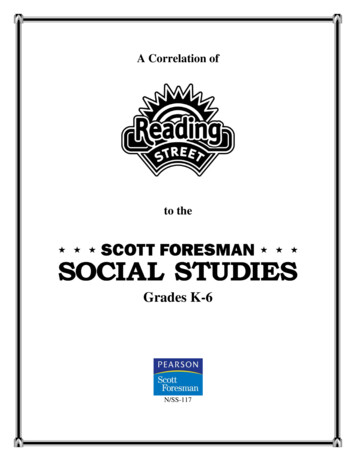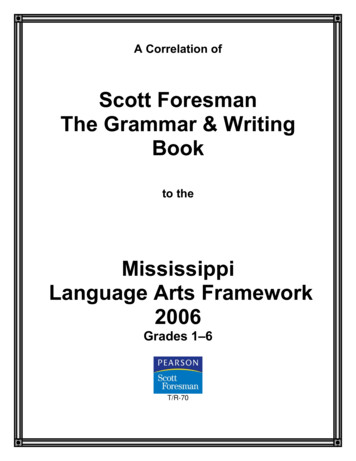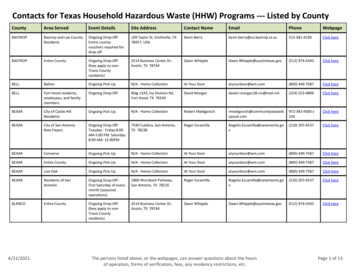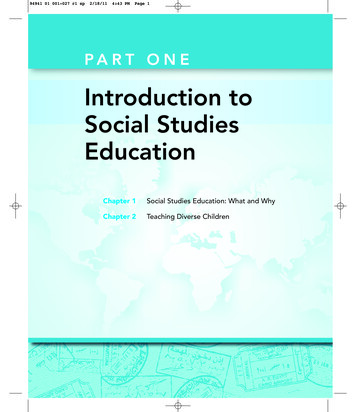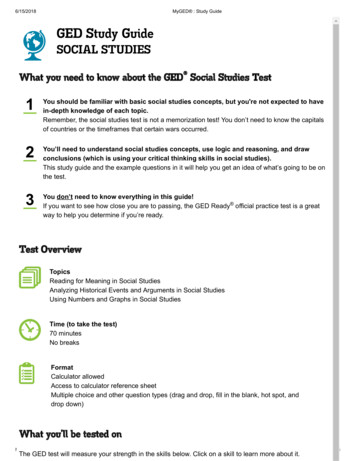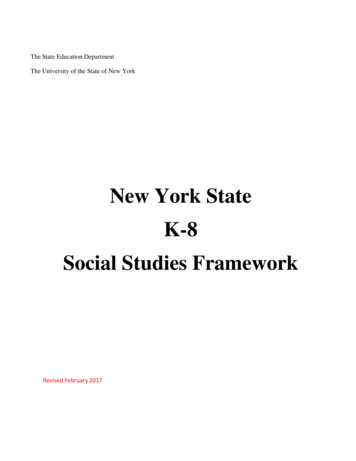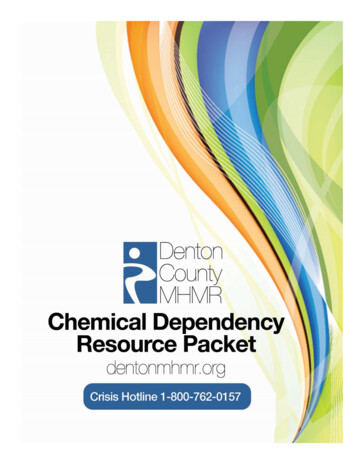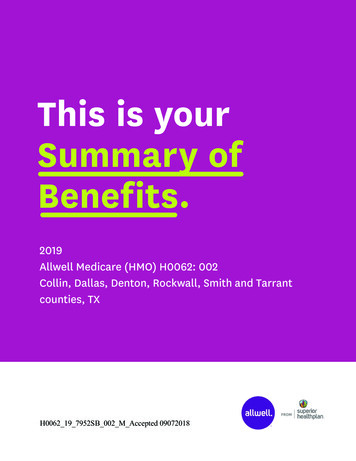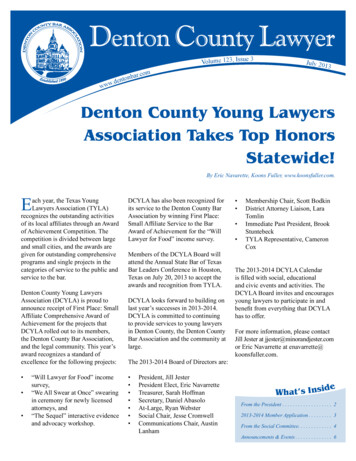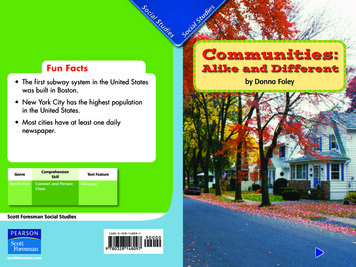
Transcription
Communities:Fun FactsAlike and Different The first subway system in the United Stateswas built in Boston. New York City has the highest populationin the United States. Most cities have at least one ntext and PictureCluesText FeatureGlossaryScott Foresman Social StudiesISBN 0-328-14809-1ì (sk m) beiajh -Ä-U-Ä-Uby Donna Foley
In this book you will read aboutdifferent communities. You will explorewhat communities might have in commonand what might make them different.VocabularycommunityurbansuburbruralWrite to It!Describe your favorite kind ofCommunities:community. How is it the sameAlikeandand differentfrom Differentwhere you livenow? WritebyoneparagraphDonnaFoley aboutyour ideas.Write your paragraph on another sheetof paper.Every effort has been made to secure permission and provide appropriate credit forphotographic material. The publisher deeply regrets any omission and pledges tocorrect errors called to its attention in subsequent editions.ISBN: 0-328-14809-1Copyright Pearson Education, Inc.All Rights Reserved. Printed in the United States of America. This publication isprotected by Copyright, and permission should be obtained from the publisherprior to any prohibited reproduction, storage in a retrieval system, or transmissionin any form by any means, electronic, mechanical, photocopying, recording, orlikewise. For information regarding permission(s), write to: Permissions Department,Scott Foresman, 1900 East Lake Avenue, Glenview, Illinois 60025.1 2 3 4 5 6 7 8 9 10 V0G1 14 13 12 11 10 09 08 07 06 05Unless otherwise acknowledged, all photographs are the property of Scott Foresman,a division of Pearson Education.Photo locators denoted as follows: Top (T), Center (C), Bottom (B), Left (L), Right (R),Background (Bkgd)Opener: PhotoEdit; 1 PhotoEdit; 2 Thinkstock, Getty Royalty; 3 Index Stock Imagery;4 PhotoEdit; 5 Corbis; 6 Index Stock Imagery; 7 Stone/Getty Images; 8 Robert HardingPicture Library; 9 PhotoEdit; 10 PhotoEdit; 11 PhotoEdit; 12 Index Stock Imagery;Editorial Offices: Glenview, Illinois Parsippany, New Jersey New York, New York13 Image Bank/Getty Images; 14 Superstock; 15 CorbisSales Offices: Needham, Massachusetts Duluth, Georgia Glenview, IllinoisCoppell, Texas Ontario, California Mesa, Arizona
Communities are alike and differentin many ways. Communities aremade up of neighborhoods, or placeswhere people live and work together.Some communities have differentneighborhoods crowded into small areas.Each community uses land differentlyand creates neighborhoods for the peopleliving there. There are three types ofcommunities.2Urban communities have a city. Acity is a very large community with manydifferent neighborhoods close together.Urban neighborhoods are crowdedand have many buildings. Someurban neighborhoods have their ownidentity, such as Chinatown or LittleItaly. Other urban neighborhoodshave many businesses. People usuallylive in apartment buildings in urbanneighborhoods.Urban communities bring manydifferent types of cultures together.3
Suburbs are communities near cities.They have houses for families to live in.Many people who work in the city livein the suburbs. A suburb is sometimescalled a town. A suburb usually has atown center with places to shop. Theremay be many neighborhoods around thetown center.4Rural communities have a lot of openspace. Rural communities are very spreadout over the land. Many rural areas havefarms with land to grow crops or raiseanimals. People in rural communitiesusually live and work on farms. There arenot many shops in rural communities.People usually have to drive to townto shop.5
In suburban communities, peoplelive in neighborhoods with many housesnear each other. They can walk to theirneighbor’s house for a visit. Their housesusually have trees and yards aroundthem. Some families plant flowers orvegetable gardens. There is land to growall kinds of things.In urban communities, people livein neighborhoods that have lots ofapartment buildings. Many people andfamilies live in each apartment building.People sometimes walk down the hallto visit their neighbors. Families usuallydo not have their own yards. In urbanneighborhoods some families make smallgardens on their balconies by plantingflowers and vegetables in flower boxes.67
In rural communities there is usuallya lot of room between houses. Neighborsmay not live close to one another. Peoplesometimes need to drive if they want tovisit a neighbor.8In urban communities, neighborhoodsare very crowded and busy. There aremany stores and restaurants in urbanneighborhoods. People shop near theirapartments and can sometimes walk tothe market to buy food.Urban communities also have manycultural centers and parks. People canvisit museums and libraries.9
In suburban communities the towncenter may be a meeting place for people.People usually walk or drive a shortdistance to the town center. People goto town to shop. There may be a market,small shops, and a few restaurants.Families and friends meet to spend timetogether.There are also shopping mallsnear the suburbs. The shopping mallshave many types of stores. People goto shopping malls to buy things theycannot find in town.10In rural communities the town center isvery small. People need to drive to town.There is usually a market and only a fewshops. There are a few meeting places forfriends and families.In rural communities, families andfriends spend more time together athome. People need to visit bigger townsand cities to shop, eat out, or visita museum.11
In urban communities, people movequickly from place to place. Many peopleuse public transportation. People takebuses or subways to travel to places inthe city.In urban neighborhoods many peoplewalk and may not drive a car. Theirneighborhoods are too crowded forparking spaces. Driving in the city can beslow because there is a lot of traffic.12In suburban communities manypeople use cars for transportation. Streetsin suburban communities have less trafficthan city streets, so it is easier to drivefrom place to place. Other people ridebicycles or walk.There are also buses in suburbancommunities, but there are usuallyfewer buses than in urban communities.Suburbs have many buses in the morningand late afternoon. People use thesebuses to get to work and school.Many people in suburbs live far fromwhere they work. Many people work ina city near their town. Many towns havetrain stations. People take the trains tothe city.13
In rural communities, people use carsto travel from place to place. Peopleusually live too far away from places towalk. Some people ride bicycles.Buses usually do not travel fromneighborhood to neighborhood in ruralcommunities. People can take a bus fromthe town center to other towns or to thecity. There are usually only a few busesthat run each day. People may have toplan their travel around the bus schedule.14Communities are the same in manyways. Some have neighborhoods withpeople and families. People live, work,and travel in communities. People areoften connected to one another in theircommunities.Communities are different in manyways. Communities use land differentlyfor neighborhoods. Some communitieshave neighborhoods with many people.Some communities have neighborhoodswith people living near each otherand working in other communities.Communities are special places to live!15
In this book you will read aboutGlossarydifferent communities. You will explorewhat communities might have in commoncommunity a place that is made up ofand what might make them different.many neighborhoodsVocabularyruralan area with small communitiescommunityandopen spaceurbansuburb a type of community that issuburblocated near a cityruralurban an area that has a cityWrite to It!Describe your favorite kind ofcommunity. How is it the sameand different from where you livenow? Write one paragraph aboutyour ideas.Write your paragraph on another sheetof paper.Every effort has been made to secure permission and provide appropriate credit forphotographic material. The publisher deeply regrets any omission and pledges tocorrect errors called to its attention in subsequent editions.ISBN: 0-328-14809-1Copyright Pearson Education, Inc.All Rights Reserved. Printed in the United States of America. This publication isprotected by Copyright, and permission should be obtained from the publisherprior to any prohibited reproduction, storage in a retrieval system, or transmissionin any form by any means, electronic, mechanical, photocopying, recording, orlikewise. For information regarding permission(s), write to: Permissions Department,Scott Foresman, 1900 East Lake Avenue, Glenview, Illinois 60025.16 1 2 3 4 5 6 7 8 9 10V0G1 14 13 12 11 10 09 08 07 06 05Unless otherwise acknowledged, all photographs are the property of Scott Foresman,a division of Pearson Education.Photo locators denoted as follows: Top (T), Center (C), Bottom (B), Left (L), Right (R),Background (Bkgd)Opener: PhotoEdit; 1 PhotoEdit; 2 Thinkstock, Getty Royalty; 3 Index Stock Imagery;4 PhotoEdit; 5 Corbis; 6 Index Stock Imagery; 7 Stone/Getty Images; 8 Robert HardingPicture Library; 9 PhotoEdit; 10 PhotoEdit; 11 PhotoEdit; 12 Index Stock Imagery;13 Image Bank/Getty Images; 14 Superstock; 15 Corbis
Scott Foresman Social Stu
